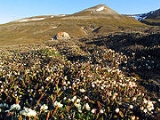
Flora of Svalbard
Encyclopedia
There are 164 vascular plant
species on the Norwegian
Arctic archipelago
of Svalbard
. This figure does not include algae, moss
es, and lichen
s, which are non-vascular plant
s. For an island so far north, 164 species constitutes an astonishing variety of plant life. Because of the harsh climate and the short growing season, all the plants are slow growing. They seldom grow higher than 10 cm.
In some areas, especially in warmer valleys, the plants produce carpets of blossoms. Svalbard has been divided into four vegetation zones ().
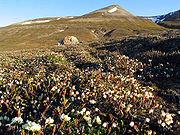

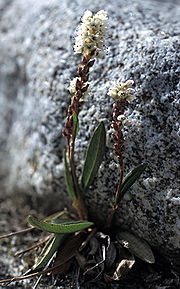
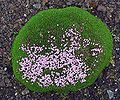
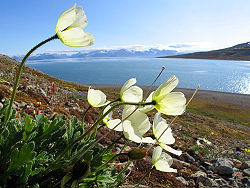
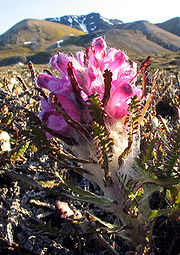
Vascular plant
Vascular plants are those plants that have lignified tissues for conducting water, minerals, and photosynthetic products through the plant. Vascular plants include the clubmosses, Equisetum, ferns, gymnosperms and angiosperms...
species on the Norwegian
Norway
Norway , officially the Kingdom of Norway, is a Nordic unitary constitutional monarchy whose territory comprises the western portion of the Scandinavian Peninsula, Jan Mayen, and the Arctic archipelago of Svalbard and Bouvet Island. Norway has a total area of and a population of about 4.9 million...
Arctic archipelago
Archipelago
An archipelago , sometimes called an island group, is a chain or cluster of islands. The word archipelago is derived from the Greek ἄρχι- – arkhi- and πέλαγος – pélagos through the Italian arcipelago...
of Svalbard
Svalbard
Svalbard is an archipelago in the Arctic, constituting the northernmost part of Norway. It is located north of mainland Europe, midway between mainland Norway and the North Pole. The group of islands range from 74° to 81° north latitude , and from 10° to 35° east longitude. Spitsbergen is the...
. This figure does not include algae, moss
Moss
Mosses are small, soft plants that are typically 1–10 cm tall, though some species are much larger. They commonly grow close together in clumps or mats in damp or shady locations. They do not have flowers or seeds, and their simple leaves cover the thin wiry stems...
es, and lichen
Lichen
Lichens are composite organisms consisting of a symbiotic organism composed of a fungus with a photosynthetic partner , usually either a green alga or cyanobacterium...
s, which are non-vascular plant
Non-vascular plant
Non-vascular plants is a general term for those plants without a vascular system . Although non-vascular plants lack these particular tissues, a number of non-vascular plants possess tissues specialized for internal transport of water....
s. For an island so far north, 164 species constitutes an astonishing variety of plant life. Because of the harsh climate and the short growing season, all the plants are slow growing. They seldom grow higher than 10 cm.
In some areas, especially in warmer valleys, the plants produce carpets of blossoms. Svalbard has been divided into four vegetation zones ().
Plant species






- Arabis alpinaArabis alpinaArabis alpina is a flowering plant in the family Brassicaceae that grows in mountainous areas of Europe, north Africa, central and eastern Asia and parts of North America. In the British Isles, it is only known to occur in a few locations in the Cuillin Ridge of the Isle of Skye.The stems of A...
- Alpine rock-cress - Arenaria pseudofrigidaArenaria (plant)Arenaria is a genus of flowering plants, within the family Caryophyllaceae.Species of this genus are among those plants commonly known as "sandworts". Several species formerly classified within Arenaria are now classed in the genera Spergularia, Eremogone and Minuartia.Species include:*Arenaria...
- Fringed sandwort - Arnica alpinaArnicaArnica is a genus with about 30 perennial, herbaceous species, belonging to the sunflower family . The genus name Arnica may be derived from the Greek arna, "lamb", in reference to the soft, hairy leaves....
- Alpine arnica - Betula nana - Dwarf birch
- Braya purpurascens - Purplish Braya
- Campanula unifloraCampanulaCampanula is one of several genera in the family Campanulaceae with the common name bellflower. It takes its name from their bell-shaped flowers—campanula is Latin for "little bell"....
- Arctic harebell - Cardamine nymaniiCardamineCardamine , is a large genus in the family Brassicaceae. It contains more than 150 species of annuals and perennials. The genus grows worldwide in diverse habitats, except in the Antarctic. Genus Dentaria is a synonym for Cardamine.The leaves can have different forms, going from minute to...
- Polar cress - Carex misandraCarexCarex is a genus of plants in the family Cyperaceae, commonly known as sedges. Other members of the Cyperaceae family are also called sedges, however those of genus Carex may be called "true" sedges, and it is the most species-rich genus in the family. The study of Carex is known as...
- Sooty sedge - Cassiope tetragonaCassiope tetragonaCassiope tetragona is a plant native to the high Arctic and northern Norway, where it is found widely....
- Arctic bell-heather - Cerastium arcticumCerastium arcticumCerastium arcticum is a flower distributed at parts of western and southern Greenland, Baffin Island, Labrador, Iceland, Scotland, Norway and Svalbard....
- Arctic mouse-ear chickweed - Cochlearia officinalisCochlearia officinalisCochlearia officinalis, or Common Scurvygrass is a flowering plant of the genus Cochlearia in the family Brassicaceae....
- Scurvy-grass - Deschampsia alpinaDeschampsiaDeschampsia is a genus of grasses in the family Poaceae, commonly known as hair grass or tussock grass. There are 30 to 40 species....
- Alpine hair-grass - DrabaDrabaDraba is a large genus of cruciferous plants, commonly known as whitlow-grasses. There are over 400 species:*Draba abajoensis Windham & Al-Shehbaz*Draba × abiskoensis O.E.Schulz*Draba × abiskojokkensis O.E.Schulz...
- D. bellii - Yellow arctic whitlow-grass
- D. lacteaDraba lacteaDraba lactea is a flower common throughout the high Arctic. It stretches further south in mountainous areas of Norway and Canada....
- Lapland whitlow-grass
- Dryas octopetalaDryas octopetalaDryas octopetala is an arctic-alpine flowering plant in the family Rosaceae. It is a small prostrate evergreen subshrub forming large colonies, and is a popular flower in rock gardens...
- Mountain avens - Empetrum nigrum - Crowberry
- Erigeron humilis - Black fleabane
- Eriophorum scheuchzeri - Arctic cottongrass
- LuzulaLuzulaLuzula is a genus of about 80 species of flowering plants the family Juncaceae, with a cosmopolitan distribution, the highest species diversity being in temperate Asia and Europe....
- L. arctica - Tundra wood-rush
- L. confusa - Arctic wood-rush
- Mertensia maritima - Oysterleaf
- Minuartia rubellaMinuartia rubellaMinuartia rubella is a species of flowering plant in the pink family known by several common names, including beautiful sandwort, Arctic sandwort, and boreal stitchwort...
- Alpine sandwort - Oxyria digynaOxyria digynaOxyria digyna a species of flowering plant in the buckwheat family. It is common in the tundra of Arctic...
- Mountain sorrel - Papaver dahlianum - Svalbard poppy
- Pedicularis
- P. dasyanthaPedicularis dasyanthaPedicularis dasyantha is a plant native to the high arctic areas of Svalbard, Spitsbergen, Novaya Zemlya, and the Jamal Peninsula of Siberia....
- Woolly lousewort - P. hirsuta - Hairy lousewort
- P. dasyantha
- Petasites frigidusPetasites frigidusPetasites frigidus is a species of Petasites native to Arctic to cool temperate regions of the Northern Hemisphere in northern Europe, northern Asia and northern North America.It is a herbaceous perennial plant producing flowering stems in early spring, and large leaves through the summer...
- Lapland butterbur - Poa alpinaPoaPoa is a genus of about 500 species of grasses, native to the temperate regions of both hemispheres. Common names include meadow-grass , bluegrass , tussock , and speargrass. "Poa" is Greek for fodder...
- Alpine meadow-grass - Polemonium borealePolemonium borealePolemonium boreale is a plant native to the most of the high arctic. In Greenland it is found only in a small area on the east coast. It is not very common....
- Boreal Jacobs-ladder - Polygonum viviparum - Alpine bistort
- PotentillaPotentillaPotentilla is the genus of typical cinquefoils, containing about 500 species of annual, biennial and perennial herbs in the rose family Rosaceae. They are generally Holarctic in distribution, though some may even be found in montane biomes of the New Guinea Highlands...
- P. chamissonisPotentilla chamissonisPotentilla chamissonis is distributed across Svalbard, northern Norway, Greenland and the eastern Arctic of Canada. It grows on ledges on steep slopes, and in crevices.-Description:...
- Bluff cinquefoil - P. hyparctica - Arctic cinquefoil
- P. pulchella - Tufted cinquefoil
- P. chamissonis
- Puccinellia phryganodes - Cushioned saltmarsh grass
- RanunculusRanunculusRanunculus is a large genus of about 600 species of plants in the Ranunculaceae. Members of the genus include the buttercups, spearworts, water crowfoots and the lesser celandine....
- R. hyperboreus - Arctic buttercup
- R. lapponicusRanunculus lapponicusRanunculus lapponicus is distributed all over the arctic, with the exception of northern and eastern Greenland....
- Lapland buttercup - R. nivalisRanunculus nivalisSnow buttercup is a species of plant in the Ranunculaceae family....
- Snow buttercup - R. pedatifidus - Lobed buttercup
- R. pygmaeusRanunculus pygmaeusRanunculus pygmaeus is a species of buttercup found throughout the Arctic, as well as in the mountains of Norway and the Rocky Mountains. A few populations also exist in the Eastern Alps and Tatra Mountains.It is a small plant, prostrate-ascending, 1-5 cm tall...
- Pygmy buttercup - R. sulphureus - Sulphur-coloured buttercup
- Rubus chamaemorus - Cloudberry
- Salix
- Salix herbacea - Snowbed willow
- Salix polaris - Polar willow
- Saxifraga
- S. aizoidesSaxifraga aizoidesSaxifraga aizoides is a flower of the genus Saxifraga. Yellow mountain saxifrage prefers cold and wet shale cliff environment and could be found in North America and Europe .-External links and references:***...
- Yellow mountain saxifrage - S. cernua - Drooping saxifrage
- S. cespitosa - Tufted saxifrage
- S. flagellarisSaxifraga flagellarisSaxifraga flagellaris is a plant native all over the high arctic and some areas of northern Rocky Mountains, and Norway. It is not very common. It is also known as Spider Saxifrage or "spider plant", though the latter name more commonly refers to the unrelated Chlorophytum comosum . The Broadsepal...
- Whiplash saxifrage - S. hieracifoliaSaxifraga hieracifoliaSaxifraga hieracifolia is a species of saxifrage distributed all over the high arctic and some alpine areas like Norway and the Carpathian Mountains, with a few isolated populations in the Central Eastern Alps of Austria and the Massif Central of...
- Hawkweed-leaved saxifrage - S. hirculus - Bog saxifrage
- S. nivalisSaxifraga nivalisSaxifraga nivalis is a species of saxifrage. It is commonly called Snow Saxifrage or "alpine saxifrage".Found on irrigated rocks or open vegetation in shaded sites, often on mountain ledges and crags with base rich substratum. This species is not very tolerant of competition and so is found in...
- Alpine saxifrage - S. oppositifolia - Purple saxifrage
- S. rivularisSaxifraga rivularisSaxifraga rivularis is a species of saxifrage known by several common names, including alpine brook saxifrage, pygmy saxifrage, and weak saxifrage.-Distribution:...
- Brook saxifrage
- S. aizoides
- SileneSileneSilene is a genus of flowering plants in the family Caryophyllaceae. Common names include campion and catchfly....
- S. acaulis - Moss campion
- S. furcata - Arctic Lychnis
- S. wahlbergella - Northern catchfly
- StellariaStellariaStellaria is a genus of about 90-120 species flowering plants in the family Caryophyllaceae, with a cosmopolitan distribution. Common names include stitchwort and chickweed.-Food use:...
- S. crassipes - Chickweed
- S. humifusaStellaria humifusaStellaria humifusa or Saltmarsh Starwort is known in Iceland as "Lágarfi" , and grows only in beach areas....
- Arctic chickweed
- TaraxacumTaraxacumTaraxacum is a large genus of flowering plants in the family Asteraceae. They are native to Eurasia and North America, and two species, T. officinale and T. erythrospermum, are found as weeds worldwide. Both species are edible in their entirety...
- T. arcticum - Arctic dandelion
- T. brachyceras - Polar dandelion
- Vaccinium uliginosumVaccinium uliginosumVaccinium uliginosum is a flowering plant in the genus Vaccinium.-Distribution:Vaccinium uliginosum is native to cool temperate regions of the Northern Hemisphere, at low altitudes in the Arctic, and at high altitudes south to the Pyrenees, the Alps, and the Caucasus in Europe, the mountains of...
- Bog bilberry

